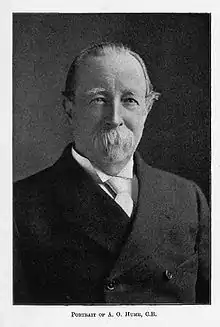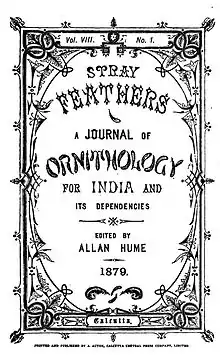Allan Octavian Hume
Allan Octavian Hume, meist nur A.O. Hume (* 6. Juni 1829 in Montrose, Angus, Schottland[1]; † 31. Juli 1912 in London, England) war ein schottischer Ornithologe, Theosoph und Politiker. Er war einer der Gründer des Indischen Nationalkongresses.

Leben und Werk
Hume wurde am 6. Juni 1829 als eines von sechs Kindern von Joseph Hume und Catherine Elizabeth Burnley im schottischen Montrose geboren. 1842 diente er als Midshipman auf der Royal-Navy-Fregatte Vangauard, besuchte anschließend das East India Company College (heute Haileybury College) bei Hertford und studierte Medizin am University College Hospital in London. 1853 heiratete er Mary Anne Grindall (1824–1890), aus der Ehe ging die Tochter Maria Jane Burnley ("Minnie") (1854–1927) hervor.[2][3] Seiner Frau widmete er den Namen des Burmafasans (Syrmaticus humiae (Hume, 1881))[4]. Die Tochter heiratete am 28. September 1881 Ross Scott in Shimla.[5]
1849 übersiedelte Hume nach Indien und erhielt einen Posten beim Indian Civil Service in Etawah. 1867 wurde er zum Commissioner of Customs (Zollbevollmächtigter) für die Nordwestprovinzen (heute Uttar Pradesh) ernannt und war von 1870 bis 1879 Sekretär im indischen Landwirtschaftsministerium. Sein Einsatz für mehr Mitsprache der Inder in innenpolitischen Bereichen führte zu Konflikten mit Großbritannien und schließlich 1879 zu seiner Rückversetzung auf eine unbedeutende Stelle in den Nordwestprovinzen. 1882 folgte die Pensionierung vom Civil Service.[2][6]

Nachdem Hume 1879 in Allahabad Helena Blavatsky und Henry Steel Olcott kennengelernt hatte, trat er 1880 der Theosophischen Gesellschaft bei und wurde 1881 Präsident der theosophischen Loge in Shimla. An der Finanzierung der Zeitschrift The Theosophist war er maßgeblich beteiligt, ebenso war Hume Empfänger mehrerer angeblich von den Meistern der Weisheit verfasster sogenannter Meisterbriefe. Nach Meinungsverschiedenheiten mit Blavatsky trat er 1883 wieder aus der Theosophischen Gesellschaft aus, hielt jedoch weiterhin Kontakt mit der Organisation und einer Reihe führender Theosophen.[7][8][9]

Hume war Herausgeber der ornithologischen Fachzeitschrift Stray feathers. Journal of ornithology for India and its dependencies, die von 1872 bis 1899 erschien.
Nach seiner Pensionierung 1882 begann sich Hume politisch zu engagieren. Er trat für mehr Demokratie und Selbstverwaltung Indiens gegenüber Großbritannien ein und war federführend an der Gründung des Indischen Nationalkongresses (INC) im Jahr 1885 beteiligt. Von seiner Gründung bis 1908 fungierte er als Generalsekretär des INC.[10][6]
Von 1862 bis 1884 betätigte er sich als Ornithologe, in dieser Zeit sammelte er rund 102.000 vogelkundliche Exponate des indischen Subkontinents. 1894 kehrte er nach England zurück und gründete 1910 das bis heute bestehende South London Botanical Institute in London.[2][11]
Die indische Post widmete ihm 1973 eine Briefmarke.[10]
Dedikationsnamen
Luigi Hildebrando Mandelli-Castelnuovo (1832–1880) benannte 1873 die Schwarzbrust-Buschtimalie (Sphenocichla humei)[12] zu seinen Ehren. William Edwin Brooks widmete ihm 1878 den Tienschan-Laubsänger (Phylloscopus humei)[13]
Sein Name findet sich außerdem in der Garteniora-Unterart (Aegithina tiphi humei Baker, ECS, 1922)[14], der Weißbauch-Schwalbenstar-Unterart (Artamus leucorynchus humei Stresemann, 1913)[15], der Tropfenkehlspecht-Unterart (Chrysophlegma mentale humii Hargitt, 1889)[16], der Grauohr-Papageimeise-Unterart (Suthora nipalensis humii Sharpe, 1883)[17], der Kernbeißer-Unterart (Coccothraustes coccothraustes humii Sharpe, 1886)[18], der Felsengimpel-Unterart (Carpodacus puniceus humii (Sharpe, 1888))[19], der Halsbandliest-Unterart (Todiramphus chloris humii (Sharpe, 1892))[20], der Indien-Rotschnabelbülbül (Hypsipetes ganeesa humii (Whistler & Kinnear, 1932))[21], der Star-Unterart (Sturnus vulgaris humii Brooks, WE, 1876)[22] und der Rötelspecht-Unterart (Micropternus brachyurus humei Kloss, 1918)[23].
Molpastes humii Oates, 1889[24] wird heute von einigen Autoren als Hybride aus Himalajabülbül (Pycnonotus leucogenis (Gray, JE, 1835)) und Weißohrbülbül (Pycnonotus leucotis (Gould, 1836)) und von anderen als Unterart des Weißohrbülbüls betrachtet.
Lophophanes Humei Brooks, WE, 1873[25] wird heute als Synonym zur Tannenmeisen-Unterart (Periparus ater aemodius (Blyth, 1845)), Megalæma hummi Marshall, CHT & Marshall, GFL, 1870[26] als Synonym für den Harlekinbartvogel (Psilopogon mystacophanos (Temminck, 1824)), Caccabis kakelik humei Zarudny, 1917[27] ein Synonym zur Chukarhuhn-Unterart (Alectoris chukar pallescens (Hume, 1873)), Turdinulus humei Hartert, E, 1902[28] ein Synonym für die Fleckenzwergdrossling-Unterart (Napothera epilepidota granti (Richmond, 1900)) und Dendrocopus macei humei Koelz, 1954[29] als Synonym für den Isabellbrustspecht (Dendrocopos macei (Vieillot, 1818)), betrachtet.
Werke (Auswahl)
- Nests and Eggs of Indian Birds (Rough Draft). Office of Superintendent of Government Printing, Kalkutta 1873 (books.google.de – 1873-1875).
- Novelities. In: Stray feathers. Journal of ornithology for India and its dependencies. Band 1, Nr. 5, 1873, S. 404–415 (biodiversitylibrary.org).
- The Islands of the Bay of Bengal. In: Stray feathers. Journal of ornithology for India and its dependencies. Band 2, Nr. 1, 1874, S. 29–324 (biodiversitylibrary.org).
- A first List of Birds of the Tenasserim Provinces. In: Stray feathers. Journal of ornithology for India and its dependencies. Band 2, Nr. 6, 1874, S. 467–484 (biodiversitylibrary.org).
- A speech on the Indian National Congress, its origin, aims and objects, delivered. Calcutta Central Press Co., Calcutta 1888.
- Agricultural Reform in India. W.H. Allen & Co., London 1879.
- Novelities? Callophasis huminæ, Sp. Nov. Mrs. Hume's Pheasant. In: Stray feathers. Journal of ornithology for India and its dependencies. Band 9, Nr. 4, 1880, S. 461–467 (biodiversitylibrary.org).
- S.R. Mehrotra, Edward C. Moulton (Hrsg.): Selected writings of Allan Octavian Hume. Oxford University Press, Oxford 2004, ISBN 0-19-565896-5.
- The game birds of India, Pakistan, Bangladesh, Burma and Sri Lanka. Bhavana, New Delhi 1994.
Literatur
- William Edwin Brooks: On an undescribed species of Lophophanes. In: The journal of the Asiatic Society of Bengal. Band 42, Nr. 2, 1873, S. 57 (biodiversitylibrary.org).
- William Edwin Brooks: A few Ornithological Notes and Corrections. In: The Ibis (= 3). Band 6, Nr. 2, 1876, S. 499–232 (biodiversitylibrary.org).
- William Edwin Brooks: On an overlooked species of Reguloides. In: Stray feathers. Journal of ornithology for India and its dependencies. Band 7, Nr. 1-2, 1878, S. 128–136 (biodiversitylibrary.org).
- Edward Hargitt: Notes on Woodpeckers.-No. XVI. On some new Species of Picidæ. In: The Ibis (= 6). Band 1, Nr. 2, 1889, S. 229–232 (biodiversitylibrary.org).
- Ernst Hartert: On birds from Pahang, Eastern Malay Peninsula. In: Novitates zoologicae - A journal of zoology in connection with the Tring Museum. Band 9, Nr. 1, 1902, S. 537–580 (biodiversitylibrary.org).
- Cecil Boden Kloss: On Birds recently collected in Siam Part I. Phasianidæ-Eurylaemidæ. In: The Ibis (= 10). Band 6, Nr. 1, 1918, S. 76–114 (biodiversitylibrary.org).
- Walter Norman Koelz: Contributions from the Institute for Regional Exploration. Ann Arbor, Michigan 1954.
- Norbert Lauppert (Hrsg.): Die Mahatma-Briefe an A.P. Sinnett und A.O. Hume. Adyar Verlag, Graz 1977–1982, ISBN 3-85005-058-0 (1. Band), 3-927837-27-X (2. Band), 3-927837-28-8 (3. Band).
- Luigi Hildebrando Mandelli-Castelnuovo: New birds from Sikhim. In: Stray feathers. Journal of ornithology for India and its dependencies. Band 1, Nr. 5, 1873, S. 415–416 (biodiversitylibrary.org).
- Charles Henry Tilson Marshall, George Frederick Leycester Marshall: A new species of Babet has been passed over as an intermediate state of the young of Megalaema mystacophanus (Temminck). In: The Ibis (= 2). Band 6, Nr. 2, 1870, S. 536–538 (biodiversitylibrary.org).
- Eugene William Oates: The Fauna of British India including Ceylon and Burma published under the Authority of the Secretary of State for India in Councii Edited by W.T. Blanfort Birds. Band 1. Taylor & Francis, London 1889 (biodiversitylibrary.org).
- Nikolai Alexejewitsch Sarudny: Къ вопросу о формахъ каменной куроnatkr (Caccabis kakelik Falk .) - Zur Frage von den Formen des Felsenhuhns (Caccabis kakelik Falk.). In: Орнитологический Вестник - Messager ornithologique - Ornithologische Mitteilungen. Band 5, Nr. 1, 1914, S. 52–60 (biodiversitylibrary.org).
- Richard Bowdler Sharpe: Catalogue of the Passeriformes, or Perching Birds in the collection of the British Museum. Cichlomorpae: Part IV. containing the concluding of the family Timelinae (Babbling Thrushes). Band 7. Order of the Trustees, London 1883 (biodiversitylibrary.org).
- Richard Bowdler Sharpe: Notes on Specimens in the Hume Collection of Birds. In: Proceedings of the Scientific Meetings of the Zoological Society of London for the Year 1886. Nr. 1, 1886, S. 96–97 (biodiversitylibrary.org).
- Richard Bowdler Sharpe: Catalogue of the Passeriformes, or Perching Birds in the collection of the British Museum. Fringilliformes: Part III. containing the family Fringilidae. Band 12. Order of the Trustees, London 1888 (biodiversitylibrary.org).
- Richard Bowdler Sharpe: Catalogue of Birds in the British Museum. Band 17. Order of the Trustees, London 1893 (biodiversitylibrary.org – 1892).
- Erwin Stresemann: Ornithologische Miszellen aus dem Indo-Australischen Gebiet. II. Teil. In: Novitates zoologicae - A journal of zoology in connection with the Tring Museum. Band 20, Nr. 1, 1913, S. 289–324 (biodiversitylibrary.org).
- Edward Charles Stuart Baker: Fauna of British India, including Ceylon and Burma. Publisghed under the Authority of the Secretary of State for India in Council. Edited by Sir Arthur E. Shipley, O.B. E., A.A.; Sc.D. Cantab., Hon. D. Sc. Princeton, Hon. LL. D. Michigan, F.R.S. 2. Auflage. 1 (Birds). Taylor and Francis, London 1922 (biodiversitylibrary.org).
- William Wedderburn: Allan Octavian Hume, father of the Indian National Congress, 1829-1912. Oxford University Press, Oxford 2002, ISBN 0-19-565287-8.
- Hugh Whistler, Norman Boyd Kinnear: The Vernay Scientific Survey of the Eastern Ghats (Ornithological Section) Part II. In: The Journal of the Bombay Natural History Society. Band 35, Nr. 4, 1932, S. 737–770 (biodiversitylibrary.org).
- Bishamber Dayal Yadav: A.O. Hume, B.D. Yadav, S.R. Bakshi, Indian freedom fighters, struggle for independence. Anmol, New Delhi 1991, ISBN 8170415279.
Weblinks
- Allan Octavian Hume, British colonial official. Encyclopædia Britannica (englisch).
- Allan Octavian Hume. Kurze Biografie der Indischen Post anlässlich der Herausgabe einer Gedenkbriefmarke (englisch)
Einzelnachweise
- Als Geburtsort wird manchmal auch St Mary Cray, Kent (heute London Borough of Bromley), England angegeben.
- Hume, Allan Octavian (1829-1912) Kurzbiografie auf dem Portal Zoonomen, abgerufen am 13. Dezember 2019 (englisch).
- Stammbaum von Joseph Hume (Memento vom 16. April 2005 im Internet Archive).
- Allan Octavian Hume (1880) (Callophasis huminæ), S. 461.
- British Newspaper Archive
- Allan Octavian Hume, British colonial official. Encyclopædia Britannica (englisch).
- Mark Bevir: Theosophy as a Political Movement. In: A. Copley (Hrsg.): Gurus and their Followers: New Religious Reform Movements in Colonial India. Oxford University Press, Delhi 2000.
- The Theosophical Movement, 1875–1950. The Cunningham Press, Los Angeles 1951, Seite 70.
- The unknown side of Hume. The Hindu, 21. September 2004 (Buchbesprechung von Selected Writings of Allan Octavian Hume. Bd. 1, 1829-1867).
- Allan Octavian Hume, Issue Date 31/07/1973. Indian Post.
- About us. South London Botanical Institute.
- Luigi Hildebrando Mandelli-Castelnuovo (1873), S. 415.
- William Edwin Brooks (1878), S. 131.
- Edward Charles Stuart Baker (1922), S. 342.
- Erwin Stresemann (1913), S. 291.
- Edward Hargitt (1889), S. 231.
- Richard Bowdler Sharpe (1883), S. 486 & 487.
- Richard Bowdler Sharpe (1886), S. 97.
- Richard Bowdler Sharpe (1888), S. 433.
- Richard Bowdler Sharpe (1892), S. 281 Tafel 8.
- Hugh Whistler u. a. (1932), S. 754.
- William Edwin Brooks (1876), S. 500.
- Cecil Boden Kloss (1918), S. 109.
- Eugene William Oates (1889), S. 268 & 274.
- William Edwin Brooks (1873), S. 57.
- Charles Henry Tilson Marshall u. a. (1870), S. 536.
- Nikolai Alexejewitsch Sarudny (1914), S. 54 & 57.
- Ernst Hartert (1914), S. 564.
- Walter Norman Koelz (1954), S. 22.